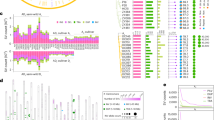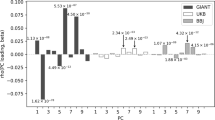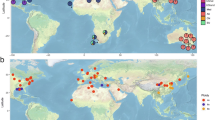Abstract
Five polymorphic enzyme genes (Est-1, Est-5, Got-2, Pgi-2 and 6-Pgdh-1) were studied in Lower Austrian populations of the herbaceous, allogamous polyploid complex Galium pusillum agg. Allele frequencies in the relic G. austriacum-2x document a high amount of genetic differentiation between the isolated, rather uniform and stenoecious populations which are separable into an older mountain and a more recent foothill series. Genetic divergence from G. austriacum-2x is small in G. austriacum-4x and only somewhat greater in G. pumilum-8x. Allele frequencies in the 4x (and 8x) suggest tetrasomic inheritance and autopolyploid behaviour in spite of nearly exclusive bivalent formation. The amount of genie variation (number of different alleles and average heterozygosity) appears uniform in diploids and polyploids. In contrast, the polyploids exhibit much increased genotypic variation as compared to the diploids. This can be linked to their more continuous, variable, euryoecious and expansive populations.
Similar content being viewed by others
Article PDF
References
Adams, W T, and Allard, R W. 1977. Effect of polyploidyon phosphoglucose isomerase diversity in Festuca micro-stachys. Proc natl Acad Sci USA, 74, 1652–1656.
Ayala, F J, Powell, J R, Tracey, M L, Mourao, C A, and Perez-Salas, S. 1972. Enzyme variability in the D. willistoni group. IV. Genic variation in natural populations of D. willistoni. Genetics, 70, 113–139.
Babbel, G R, and Selander, R K. 1974. Genetic variability in edaphically restricted and widespread plant species. Evolution, 28, 619–630.
Barber, H N. 1970. Hybridization and the evolution of plants. Taxon, 19, 154–160.
Bingham, E T. 1980. Maximizing heterozygosity in auto-polyploids. In Lewis, W. H. (ed.) Polyploidy—Biological Relevance, Plenum Press, New York, pp. 471–489.
Cavalli-Molina, S, Motfa, E P V, Schiengold, M, and Winge, H. 1989. Identical isoenzyme patterns in sib plants of Relbunium hypocarpium (Rubiaceae). Rev Brasil Genet, 12, 361–368.
Crawford, D J. 1985. Electrophoretic data and plant speciation. Syst Bot, 10, 405–416.
Crawford, D J, and Bayer, R I. 1981. Allozyme divergence in Coreopsis cyclocarpa (Compositae). Syst Bot, 6, 373–379.
Crawford, D J, and Smith, E B. 1984. Allozyme divergence and intraspecific variation in Coreopsis grandiflora (Compositae). Syst Bot, 9, 219–225.
Davis, B. 1964. Disc electrophoresis. II. Method and application to human serum proteins. Ann N Y Acad Sci, 121, 404–427.
Ehrendorfer, F. 1949. Zur Phylogenie der Gattung Galium. I. Polyploidie und geographisch-ökologische Einheiten in der Gruppe des Galium pumilum Murray (Sect. Leptogalium Lange) im österreichischen Alpenraum. Österr Bot Z, 96, 109–138.
Ehrendorfer, F. 1953. Ökologisch-geographische Mikrodifferenzierung einer Population von Galium pumilum Murray (Sect. Leptogalium Lange). (Zur Phylogenie der Gattung Galium. III.) Österr Bot Z, 100, 670–638.
Ehrendorfer, F. 1962. Cytotaxonomische Beiträge zur Genese der Mitteleuropäischen Flora und Vegetation. Ber Deutsch Bot Ges, 75, 137–152.
Ehrendorfer, F. 1980. Polyploidy and distribution. In Lewis, W. H. (ed.) Polyploidy—Biological Relevance, Plenum Press, New York, pp. 45–60.
Ehrendorfer, F. 1988. Stability versus change, or how to explain evolution. In Greuter, W. and Zimmer, B. (eds) Proc XIV—Inst Bot Congr, Berlin 1987, Koeltz, BRD, Königstein, pp. 317–333.
Gottlieb, L D. 1975. Allelic diversity in the outcrossing annual plant Stephanomeria exigua ssp. carotifera (Compositae). Evolution 29, 213–225.
Gottlieb, L D. 1977. Electrophoretic evidence and plant systematics. Ann. Missouri Bot. Gard, 64, 161–180.
Gottlieb, L D. 1981. Electrophoretic evidence and plant populations. Progress Phytochem, 7 1–46.
Hamrick, J L. 1987. Gene flow and distribution of genetic variation in plant populations. In Urbanska, K. M. (ed.) Differentiation Patterns in Higher Plants, Academic Press, London, pp. 53–67.
Harris, H, and Hopkinson, D A. 1976. Hand book of Enzyme Electrophoresis in Human Genetics. North-Holland Publ. Comp., Amsterdam.
Hedrick, P W. 1971. A new approach to measuring genetic similarity. Evolution, 25, 276–280.
Hurka, H. 1980. Enzymes as a taxonomic tool: a botanist's view. In Bisby, F. A., Vaughan, T. A. and Wright, C. A. (eds) Chemosystematics: Principles and Practice, Academic Press, London and New York, pp. 103–121.
Hurka, H, Freundner, S T, Brown, A H D, and Plant-Holt, U. 1989. Aspartate aminotransferase isozymes in the genus Capsella (Brassicaceae): Subcellular location, gene duplication, and polymorphism. Biochem Gen, 27, 77–90.
Levin, D A. 1978. Genetic variation in annual Phlox: self-compatible versus self-incompatible species. Evolution, 32, 245–263.
Loveless, M D, and Hamrick, J L. 1984. Ecological determinants of genetic structure in plant populations. A Rev Ecol Syst, 15, 65–95.
Lowrey, T K, and Crawford, D J. 1985. Allozyme divergence and evolution in Tetramolopium (Compositae: Astereae) on the Hawaiian Islands. Syst Bot. 10, 64–72.
Lumaret, R. 1981. Etude de l'hérédité de phosphatases acides chez le Dactyle (Dactylis glomerata L.) diploïde et tétraploïde. Can J Genet Cytol, 23, 513–353.
Lumaret, R. 1982. Protein variation in diploid and tetraploid orchard grass (Dactylis glomerata L.): formal genetics and population polymorphism of peroxidases and malate dehydrogenases. Genetica, 57, 207–215.
Lumaret, R. 1984. The role of polyploidy in the adaptive significance of polymorphism at the Gotl locus in the Dactylis glomerata complex. Heredity, 52, 153–169.
Lumaret, R, and Barrientos, E. 1990. Phylogenetic relationships and gene flow between sympatric diploid and tetraploid plants of Dactylis glomerata L. Pl Syst Evol, 169, 81–96.
Lumaret, R, Guillerm, J L, Delay, J, Ait Lhaj Loutfi, A, Izco, J, and Jay, M. 1987. Polyploidy and habitat differentiation in Dactylis glomerata L. from Galicia (Spain). Oecologia, 73, 436–446.
Manos, P S, and Fairbrothers, D E. 1987. Allozyme variation in populations of six northeastern American red oaks (Fagaceae: Quercus subg. Erythrobalanus). Syst Bot, 12, 365–373.
Nei, M. 1972. Genetic distance between populations. Am Nat, 106, 283–292.
Roose, M L, and Gottlieb, L D. 1976. Genetic and biochemical consequences of polyploidy in Tragopogon. Evolution, 30, 817–830.
Sanchez De La Hoz, P, and Fominaya, A. 1989. Studies of isozymes in oat species. Theor appl Genet, 77, 735–741.
Schwaegerle, K W, Garbutt, K, and Bazzaz, F A. 1986. Differentiation among nine populations of Phlox. I. Electrophoretic and quantitative variation. Evolution, 40, 506–517.
Sneath, P H A, and Sokal, R R. 1973. Numerical Taxonomy.Freeman, San Francisco.
Soltis, D E, and Riesenberg, L H. 1986. Autopolyploidy in Tolmiea menziesii (Saxifragaceae): Genetic insights from enzyme electrophoresis. Am J Bot, 73, 310–318.
Werth, C R, Guttman, S I, and Hardy Eshbaugh, W. 1985. Electrophoretic evidence of reticulate evolution in the Appalachian Asplenium complex. Syst Bot, 10, 184–192.
Author information
Authors and Affiliations
Rights and permissions
About this article
Cite this article
Samuel, R., Pinsker, W. & Ehrendorfer, F. Allozyme polymorphism in diploid and polyploid populations of Galium. Heredity 65, 369–378 (1990). https://doi.org/10.1038/hdy.1990.106
Received:
Issue date:
DOI: https://doi.org/10.1038/hdy.1990.106
This article is cited by
-
Meiotic chromosome pairing behaviour of natural tetraploids and induced autotetraploids of Actinidia chinensis
Theoretical and Applied Genetics (2014)
-
Meiotic chromosome pairing in Actinidia chinensis var. deliciosa
Genetica (2012)
-
Enzyme analysis of genetic variation and relationships in diploid and polyploid taxa ofGalium (Rubiaceae)
Plant Systematics and Evolution (1996)
-
Clone identification and clinal allozyme variation in populations ofAbies alba from the Eastern Alps (Austria)
Plant Systematics and Evolution (1992)
-
Allozyme diversity and systematics inAnnonaceae—a pilot project
Plant Systematics and Evolution (1991)



